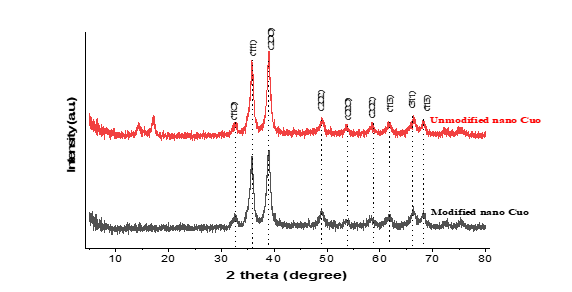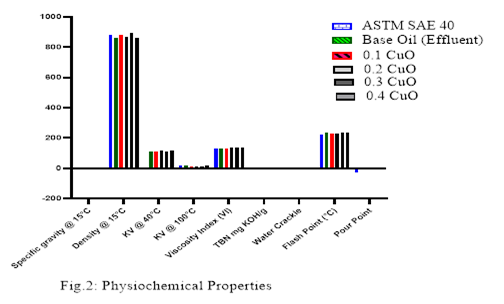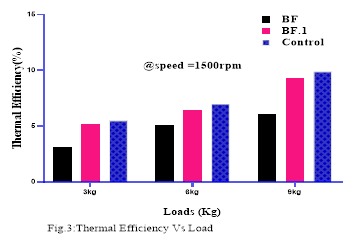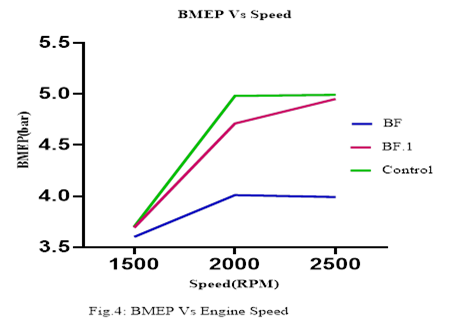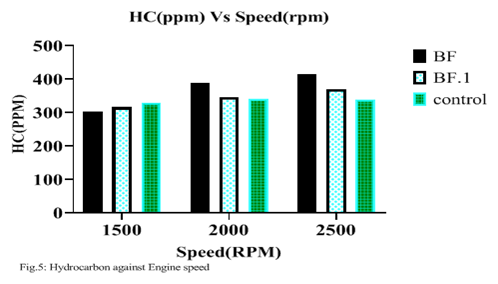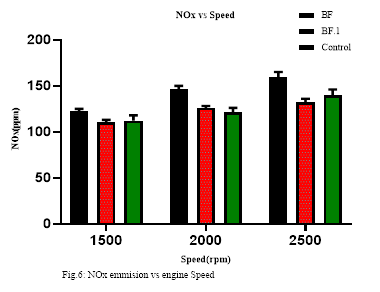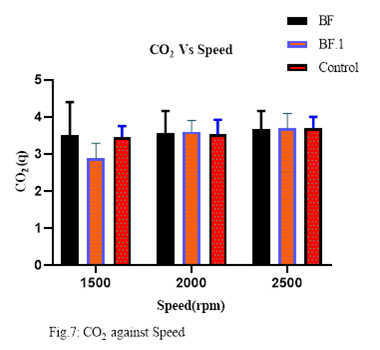Influence of Copper Oxide Nano-particles on Power and Combustion Characteristics of Industrial Waste Water Sourced Diesel Fuel.
- Umar Faruk Bakari
- Babajo Umar Abubakar
- Muktar Bello
- Iliyasu Idris Kirim
- 504-512
- Mar 21, 2024
- Engineering
Influence of Copper Oxide Nano-particles on Power and Combustion Characteristics of Industrial Waste Water Sourced Diesel Fuel.
Umar Faruk Bakari1, Babajo Umar Abubakar1, Muktar Bello1, Iliyasu Idris Kirim2,
1Department of Mechanical Engineering, Adamawa State Polytechnic Yola.
2Department of Mechanical Engineering, Taraba State Polytechnic Suntai.
DOI: https://doi.org/10.51244/IJRSI.2024.1102040
Received: 08 February 2024; Revised: 14 February 2024; Accepted: 20 February 2024; Published: 21 March 2024
ABSTRACT
With the UN global target of achieving the net zero emissions by 2050, and the world energy demands, it is necessary to transit to renewable sources of energy. In this paper, Base fuel (BF) was extracted from the effluent discharge of Lube oil Nigeria using effluent management plant. A CuO nano particle synthesized from copper acetate and sodium hydroxide precursors was dispersed into the Base Fuel with varying percentage weights of 0.1 wt%, 0.2 wt%, 0.3 wt %, and 0.4 wt% by ultra sonication and the Nano copper fuels were labeled as BF.1, BF.2, BF.3 and BF.4, the nano fuel with 0.1wt% (BF.1) presented the best physico chemical properties of 0.883, 883.0, 109.2, 13.85, 123.0, 6.12,223 and -10.6 for Specific gravity @ 15°C, Density @ 15°C, Kg/m3, KV @ 40°C, cSt, KV @ 100°C, cSt, Viscosity Index (VI), TBN mg KOH/g, Flash Point (°C) and Pour Point, (°C) respectively. BF, BF.1 and ASTM SAE 40 were then tested on a diesel engine test rig at various engine speeds of 1500 rpm, 2000 rpm, and 2500 rpm and loads of 3, 6 and 9kg respectively. It was found that that performance and emission characteristics can be increased with the addition of 0.1 wt% Cu O nano-particle. The thermal efficiency (TE) increased by 2.80%, 4.48% and 3.13% respectively for BF, BF.1 and the Control sample. This is accompanied by an increased in the BMEP by 2.69%, 0.10% for the BF.1 and control while a reduction of 2.56% was observed for BF at the maximum load. The BF.1 shows 0.46% less NOx and Smoke emission was all most 4.3% less for BF.1 when compared to BF. At maximum load of 9kg, the CO emission BF.1 is lower than that of BF by 0.42%, the Nox emission was reduced by 9.28% and the CO2 is reduced by 0.41%.
INTRODUCTION
Several states, including Lagos, Kano, Port Harcourt, Kaduna, and Ibadan, have established petroleum businesses, oil and gas sectors, and oil blending plants in an effort to meet the nation’s energy needs. Due to the presence of heavy metals, inorganic materials, and microorganisms, these industrial activities have resulted in the generation of tons of pollutants, particularly industrial wastewater or industrial effluent, which, if improperly disposed of, can cause serious health challenges for humans and affect both aquatic and terrestrial animals (Mahroogi et al., 2022; Narayan et al., 2022; Okereke et al., 2016).
An internal combustion engine, the diesel engine—also known as a compression ignition engine—uses compression heat to ignite and burn fuel that is pushed into the combustion chamber. Diesel engines function using the diesel cycle, which is often referred to as the constant pressure cycle. Fuel is atomized and sprayed into the cylinder while the air inside is compressed during the compression stroke. It is thought that a constant pressure is used for spraying. Diesel engines are an essential component of both on- and off-road vehicle power systems. Due to their well-known dependability and efficiency, diesel engines power the majority of heavy-duty trucks and buses. The world’s growing modernization has resulted in a rise in fuel use, which has raised the cost of fuels and depleted oil reserves, release of greenhouse gases and consequent global warming. Due to this, researchers are currently looking into alternative fuels to run diesel engines. As an alternative fuel to diesel, biodiesel is defined as methyl or ethyl esters of fatty acids derived from vegetable or animal fats (D’Silva et al., 2017).
Fuel Additives
Many studies have been conducted in the area of gasoline additives, including those with diethylene glycol ethyl ether (DEGEE), monoethylene glycol butyl ether (EGBE), and monoethylene glycol ethyl ether (EGEE). Improved cetane numbers have been observed with the addition of DEGEE to base diesel fuel, however lower cetane numbers have been observed with the addition of EGEE and EGBE. According to F. Gomez-Cuenca et al. (2011), these substances significantly reduce the viscosity of diesel fuel while also improving its lubricity. Generally, all the compounds listed above prove to reduce CO and hydrocarbon emissions, but not smoke. The organic compounds of Mn, Mg, Cu and Ca metals are also used as Diesel fuel additive. The organic based manganese drops the viscosity and flash point, and has also been reported to improve the contents of the exhaust gases (Gomez-Cuenca et al., 2011).
The catalytic activity of the CeO2 nanoparticles may have contributed to the notable decrease in hydrocarbon (HC) and NOx emissions as well as the improvement in brake thermal efficiency that was seen in a diesel engine using a blend of cerium oxide (CeO2) and jatropha biodiesel (Sajith et al., 2010). The aluminum nanofluid additive blended with diesel fuel increased the exhaust emission concentration and reduced the fuel consumption considerably (Kao et al., 2017). Alumina nano additive (25 and 50 ppm) blended biodiesel fuel with 5% of water content by volume in a diesel engine resulted in a major improvement in the performance and reduction in dangerous emissions, such as NOx and smoke (Sadhik Basha, J. and R. B. Anand, 2010). Experiments on ceria nanoparticles dispersed with biodiesel-ethanol blends have shown improved brake thermal efficiency (BTE) and reduction in the ignition delay and hazardous emissions.
The present study used Copperoxide nanoparticles which physically looks brownish black powder. Metal oxides such as CuO, have attracted attention mostly because of their anti mic robial and biocide properties and they may be used for biomedical applications. Copper oxide is a semiconductor metal, which has a unique optical, electrical and magnetic properties and it has been used for various applications, such as super capacitors, near infrared filters, magnetic storage media, sensors, catalysis, semiconductors. However, their heat carrying capacity was most helpful in completing this investigation. Being a transition metal oxide, it helps in carrying out the heat from the engine to the exhaust, thereby reducing the NOx emissions.
MATERIALS AND METHOD
2.1 Materials
The primary resource utilized in this investigation was the wastewater produced by lubricating oil mixing plants, which are extensively produced in Nigeria. Oil (BF) was extracted utilizing an effluent waste management system. Following several steps of separation, phosphoric acid was utilized to purify the oil (S. Lawal et al., 2023). Materials used in the CuO nanoparticles production includes; copper acetate and sodium hydroxide as CuO precursors, oleic acid, ethanol and distilled water (Kiranmayi et al., 2018; Umaru et al., 2017)
2.2 Preparation of Nano Fuel
An Ultrasonic Bath Sonicator was used to disperse the nanoparticles into the fuel. The fuel for investigation was a BF.1, BF.2, BF.3 and BF.4 blend of effluent extract (90% of BF and 10-40% of Nanocopper oxide powder). The fuel additive used were Copper Oxide nanoparticles of <50nm in size. The dosage of the nanoparticles is varied from 10mg/l to 40mg/l. The required quantity of the nanoparticle for each sample is accurately measured using a precision electronic balance. The modified fuel is utilized immediately after preparation, in order to avoid any settling or for sedimentation to occur.
2.2.1 Purification of the Base Fuel
Following the careful separation of the oil from the water mixture in the Effluent Management Plant, the effluent oil was then purified using phosphoric acid to eliminate any phospholipids that might be accompanied in the oil due to its prior contact with water in the separation, and as well to flush any contaminants contained in the oil. A 2500ml of the oil was heated to 85 0C and carefully transferred to a round beaker, 100 ml phosphoric acid was measured and added to the preheated oil and allowed to mix intimately for an hour. The mixture was then allowed to cool at ambient temperature for 24 hrs, the refined oil was collected and filtered as suggested by (Muhammad et al., 2022; Kaisan et al., 2021; S. lawal et al., 2023).
2.2.2 Blending
The as prepared nano copper-based effluent fuel samples were prepared by dispersing the treated (surface-modified) CuO nanoparticles into the purified effluent oil to the concentrations of 0.1 wt%, 0.2 wt%, 0.3 wt%, and 0.4 wt%, respectively. Each of the Copper-based samples was stirred for 15 min one after the other (Ismail et al., 2020). To obtain homogeneity and prevent agglomeration of the dispersed nanoparticles within the base oil, ultrasonication of the samples was done using a Digital Pro+ Sonication device after stirring. The sonication of oil samples was conducted at 59 Hz frequency, 100% power, and temperature of 75 ◦C for 2 h (Jaleel et al., 2021). It was observed that the likely optimal dispersion stability was between 80- 100 min duration. Same was reported by (Nugroho et al., 2021; S. lawal et al., 2023). Effect of gas burbles and moisture accompanying the samples were removed by an hour vacuum drying as also suggested by (Kaisan et al., 2015; Kaisan et al., 2016; Muhammad et al., 2014). Samples were coded as shown in Table 1.
2.3 Measurement of Properties of Nanofuel
The coded fuel samples are tested for their physio chemical properties like viscosity, fire point, density and calorific value using the ASTM methods. These properties affect the performance and emission features of an engine. Redwood viscometer is used for viscosity measurement, Penksy Martin apparatus is used for measurement of fire point. Calorific value is found out using bomb calorimeter.
2.4 Performance and Emission Testing
Using a computerized single cylinder four-stroke, naturally aspirated, Direct Injection and water-cooled, variable compression ratio diesel engine test Rig of 3.5 kW rated power is used to conduct the test. The compression ratio of the engine can be varied from 12:1 to 18:1. It is directly coupled to an eddy current dynamometer. The setup has standalone type independent panel box consisting of air box, fuel tank, manometer, fuel measuring unit, transmitters for air flow and fuel flow measurements, process indicator and engine indicator. For measurement of water flow rate for engine cooling and exhaust gas calorimeter, rotameters are provided. An AVL Digas 444 five gas Exhaust gas analyzer, is used to measure the NOx (PPM), CO (q), CO2 (q) and HC (PPM) emissions in the exhaust.
RESULTS AND DISCUSSION
3.1 XRD Analysis
Figure1. Shows the XRD pattern of the synthesized CuO nano particles, it presented a single-phase with a monoclinic structure. Lattice parameters were a = 4.84 Å, b = 3.47 Å, c = 5.33 Å. The intensities and positions of peaks are in accordance with the reported values (JCPDS file No. 05-661). Fig. 1: XRD of CuO nano particles. The broader peaks could be attributed to smaller crystals or a possible defect. The average crystallite size of CuO nano particles was found to be 8.25 nm using the Scherrer formula. This was similar to the result obtained by Amrut et al., 2010).
Fig. 1: XRD of CuO nano particles
Source: S. Lawal et al., (2023).
3.2 Physio chemical Characterization
| Table 1: Physio chemical Properties of Samples | ||||||
| Properties | ASTM SAE 40 | Base Oil (Effluent) | 0.1 CuO | 0.2 CuO | 0.3 CuO | 0.4 CuO |
| Specific gravity @ 15°C | 0.884 | 0.859 | 0.883 | 0.869 | 0.892 | 0.864 |
| Density @ 15°C, Kg/m3 | 884 | 859 | 883 | 869 | 892 | 864 |
| KV @ 40°C, cSt | Report | 113.18 | 109.20 | 114.92 | 112.08 | 114.08 |
| KV @ 100°C, cSt | 12.5-16.3 | 14.46 | 13.85 | 14.30 | 14.17 | 14.53 |
| Viscosity Index (VI) | 80-135 | 130 | 132 | 134 | 134 | 136 |
| TBN mg KOH/g | 6.0 | 6.89 | 6.12 | 3.59 | 3.28 | 3.91 |
| Water Crackle | Nil | Nil | Nil | Nil | Nil | Nil |
| Flash Point (°C) | 220 | 238 | 223 | 230 | 237 | 238 |
| Pour Point, (°C) | -27 | -8.5 | -10.6 | -8.8 | -8.3 | -8.5 |
From fig.2 below, it could be seen that the 0.1 CuO addition has its physio chemical properties closed to those of ASTM SAE 40. And hence can be used for lubrication of gasoline engines for passenger cars, commercial vehicles and farm equipment as well as diesel engines for commercial vehicles and contractor equipment as suggested in many literatures. From these results it was observed that the viscosity of the BF sample increase with corresponding addition of the CuO nano particles. Literatures have been showing similar inference when nano particles are dispersed in a base fluid (A.al-Yari et al., 2024; Apmann et al., 2021; Karthikeyan et al., 2016; Binu et al., 2015).
C.I ENGINE PERFORMANCE STUDY
3.3.1 Thermal Efficiency
Fig.3. Shows the variation of Brake Thermal Efficiency Vs loads for BF and BF.1 blends. It is clear that thermal efficiency (TE) increases with increase in load and also among the samples, BF.1 has the highest thermal efficiency. At maximum load, the increase in TE is found to be 2.80%, 4.48% and 3.13% for BF, BF.1 and ASTM SAE 40 respectively. Nano particles dispersion has been reported to also increase heat transfer coefficient of the system in both laminar and turbulent regimes.
3.3.2 Brake Mean Effective Pressure
The engine performance as inclined to the brake mean effective pressure is presented in Fig.4. The brake mean effective pressure is the calculated mean pressure that would act upon observed power output, when no mechanical losses occur. This parameter behaved in similar way as torque and brake power (A. Omojola, 2015; Fer gusson, 1986; Eze and Elijah 2010). The brake me an effective pressure increased with increase in speed with the BF.1 recording higher values at all engine speeds than BF.
EXHAUST CHARACTERISTICS
3.4.1 Hydrocarbon (HC)
From Fig 5 below, it was observed that due to an increase in engine load, the hydrocarbon (HC) emissions increases. It was seen that at the maximum engine load of 9kg, all samples witnessed a relatively much higher HC emissions as compared to lower loads. At this maximum load, the HC was found to be 3.41%, for BF.1, 5.99% for BF and 2.89% for the control.
3.4.2 Oxides of Nitrogen
Fig 6 indicates that the increase in load gives a corresponding increase in NOx emissions. We note that addition of nanoparticles to biodiesel decreases the NOx emissions as in [14]. At maximum speed, BF.1 emits least NOx when compared to BF and control. It was observed that the control recorded higher values at lower speeds. At maximum speed, the decrease in NOx is found to be 0.04%, 0.02% and 0.011% for BF.1, BF and the control respectively.
3.4.3 Carbon dioxide Emission
Fig.6 shows the variation of Co2 emission with engine speed. It could be seen that CO2 emission increased with corresponding inc reased in engine speed. The BF.1 sample presents the highest CO2 emission at the maximum engine speed and this could be attributed to an improvement in the heat distribution. The percentages increased in CO2 emission were found to be 1.23%, 1.39% and 1.41% for BF, BF.1 and control respectively. Similar trend is seen the works of (Kalaimurugan et al., 2023; Chatur et al., 2023).
CONCLUSION
We have successfully produced a nano copper oxide from two precursors; copper acetate and sodium hydroxide and dispersed the produced nano copper oxide nCuO into the base fluid (BF) with the aid of ultrasonication. Based on the experimental results, the dispersion of the 0.1wt% nCuO into the base fluid had improved the physiochemical properties of the nanofluid, increased heat transfer coefficient and consequently enhanced engine performance. The 0.1wt% nCuO also lead to relatively complete combustion and less emission owing to its intimate mixing with air.
REFERENCE
- Kalaimurugan, K.zarthikeyan,S Periyasamy, M., Mahendran, G., & Dharmaprabhakaran, T. (2023). Experimental studies on the influence of copper oxide nanoparticle on biodiesel-diesel fuel blend in CI engine. Energy Sources, Part A: Recovery, Utilization, and Environmental Effects, 45(3), 8997-9012.
- Chatur, M. G., Maheshwari, A., & Campli, S. (2023). Investigation of waste cooking oil–diesel blends with copper oxide additives as fuel for diesel engine under variations in compression ratio. International Journal of Energy and Environmental Engineering, 14(4), 791-802.
- F. Gomez-Cuenca, M. Gomez-Marín, M.B. Folgueras-Díaz, 2011, ‘Effects of ethylene glycol ethers on diesel fuel properties and emissions in a diesel engine’, Energy Convers. Manage, 52, pp 3027–3033.
- Sajith, V., C. B. Sobhan, and G. P. Peterson. 2010. Experimental investigations on the effects of cerium oxide nanoparticle fuel additives on biodiesel. Advances in Mechanical Engineering 2:1–6.
- Sadhik Basha, J., and R. B. Anand. 2010. Effects of alumina nanoparticles blended jatropha biodiesel fuel on working characteristics of a diesel engine. International Journal of Industrial Engineering and Technology 2:53—62.
- S. Karthikeyan, A. Elango & A. Prathima, 2016, The effect of cerium oxide additive on the performance and emission characteristics of a CI engine operated with rice bran biodiesel and its blends, International Journal of Green Energy, Vol. 13, No. 3, 267–273.
- Binu K. G, Spoorthi M, Neil Vaz, Rolvin D’Silva, Pai R, 2015, Formulation and Viscosity Analysis of TiO2 Nanoparticle Dispersions in Engine Oil, American Journal of Materials Science, 5(3C): 198-202.
- Ismail, N.A., Kaisan, M.U., Balogun, M.B., Abdullahi, M.B., Faru, F.T., Ibrahim, I.U., 2020. Effects of Angle of Attack on Lift, Drag, Pitching Moment and Pressure 25 Distribution of NACA 4415 Wing. J. Sci. Technol. Educ. 8 (1), 31–42.
- Jaleel, W., et al., 2021. Using GCMS to fnd out the volatile components in the aroma of three different commercial fruits in China. J. Anim. Plant Sci. vol. 31 (1), 166–174. https://doi.org/10.36899/JAPS.2021.1.0204.
- Jacob, Ashwin, Ashok, B., Kaisan, M.U., Kulla, D.M., 2022. Influence of post-injection parameters on the performance of continuous regeneration trap to mitigate greenhouse gas and particulate emissions from CI engine. Energy 248, 123669. Published by Elsevier. June, 2022.
- R. Silambarasan & R. Senthil, 2016: Effects of nano additives on performance and emission characteristics of a diesel engine fueled with Annona methyl ester, Biofuels, DOI: 10.1080/17597269.2015.1132370.
- Kaisan, M.U., Pam, G.Y., Kulla, D.M., Kehinde, A.J., 2015. Effects of oil extraction method on biodiesel production from wild grape seeds: a case study of soxhlet extraction method and mechanical press engine driven expeller method. J. Altern. Energy Technol. 6 (1), 35–41.
- Kaisan, M.U., Anaf, F.O., Nuszkwoski, J., Kulla, D.M., Umaru, S., 2016. GC-MS analyses of biodiesel produced from cotton seed oil. Niger. J. Sol. Energy 27, 56–61.
- Kaisan, M.U., Ibrahim, I.U., Dhinesh, B., 2021. Environmental and performance evaluation of binary and ternary blend ratios of biodiesel on compression ignition engine. FUDMA J. Sci. 5 (3), 198-20. Published by Federal University, Dutsinma.
- Nugroho, A., Bo, Z., Mamat, R., Azmi, W.H., Najaf, G., Khoirunnisa, F., 2021. Extensive examination of sonication duration impact on stability of Al2O3-Polyol ester nanolubricant. Int. Commun. Heat. Mass Transf. vol. 126 (July) https://doi.org/ 10.1016/j.icheatmasstransfer.2021.105418.
- Okereke, J.N., Ogidi, O.I., Obasi, K.O., 2016. “Environmental and Health Impact of Industrial Wastewater Effluents in Nigeria-A Review,”. Int. J. Adv. Res. Biol. Sci. vol. 3 (6), 55–67 ([Online]. Available:). 〈http://s-o-i.org/1.15/ijarbs-2016-3-6-8〉
- Narayan, S., Abubakar, S., Kaisan, M.U., Hauwa, Ndagi, Tukur, Y., Gruji´c, I., Stojanovi´c, N., 2022. Dynamic Modelling of Piston the Motion in Combustion
Engines. Commun. 23 Univ. Zelina 24 (1), B9–B19. January, 2022. - Kiranmayi, P., Manyasree, D., Ravikumar, R., 2018. “Synthesis, characterization and antibacterial activity of aluminium oxide nanoparticles,”. Int. J. Pharm. Pharm. Sci. vol. 10 (1), 32. https://doi.org/10.22159/ijpps.2018v10i1.20636.
- Umaru, Samaila, Kaisan, Muhammad Usman, Usman, Shehu, Giwa, Adulraheem, 2017. Effects of Garment Laundry Activities on the Slider Lock and Crosswise Strengths of Nylon Coil Zippers. Niger. J. Mater. Sci. Eng. 7 (1), 81–86.
- Mahroogi, Faisal O., Kaisan, M.U., Narayan, S., 2022. A reduced mechanism for diesel-npentanol-diethyl-ether additive combustion. Sadhan ¯ ¯ a 47 (3), 8–17. Published by Springer.June, 2022.
- Muhammad, S.B., Kaisan, M.U., Cyprian, O.U., Sani, F., Abdulkadir, M., 2014. Performance Evaluation of a Save 80 Cook Stoves Using Controlled Cooking Test Method. J. Energy Environ. Carbon Credits 4 (2), 25–30.
- Dambatta, Y. S., Kuburi, L. S., & Kaisan, M. U. (2024). Analysis of physicochemical and tribological properties of nano alumina-based gear oil developed from effluent of lube oil blending plant. Industrial Crops and Products, 209, 117936.
- Esfe, M. H., Tamrabad, S. N. H., Toghraie, D., & Hatami, H. (2024). Presenting the best correlation relationship for predicting the dynamic viscosity of CuO nanoparticles in ethylene glycol-water base fluid using response surface methodology. Arabian Journal of Chemistry, 17(1), 105467.

